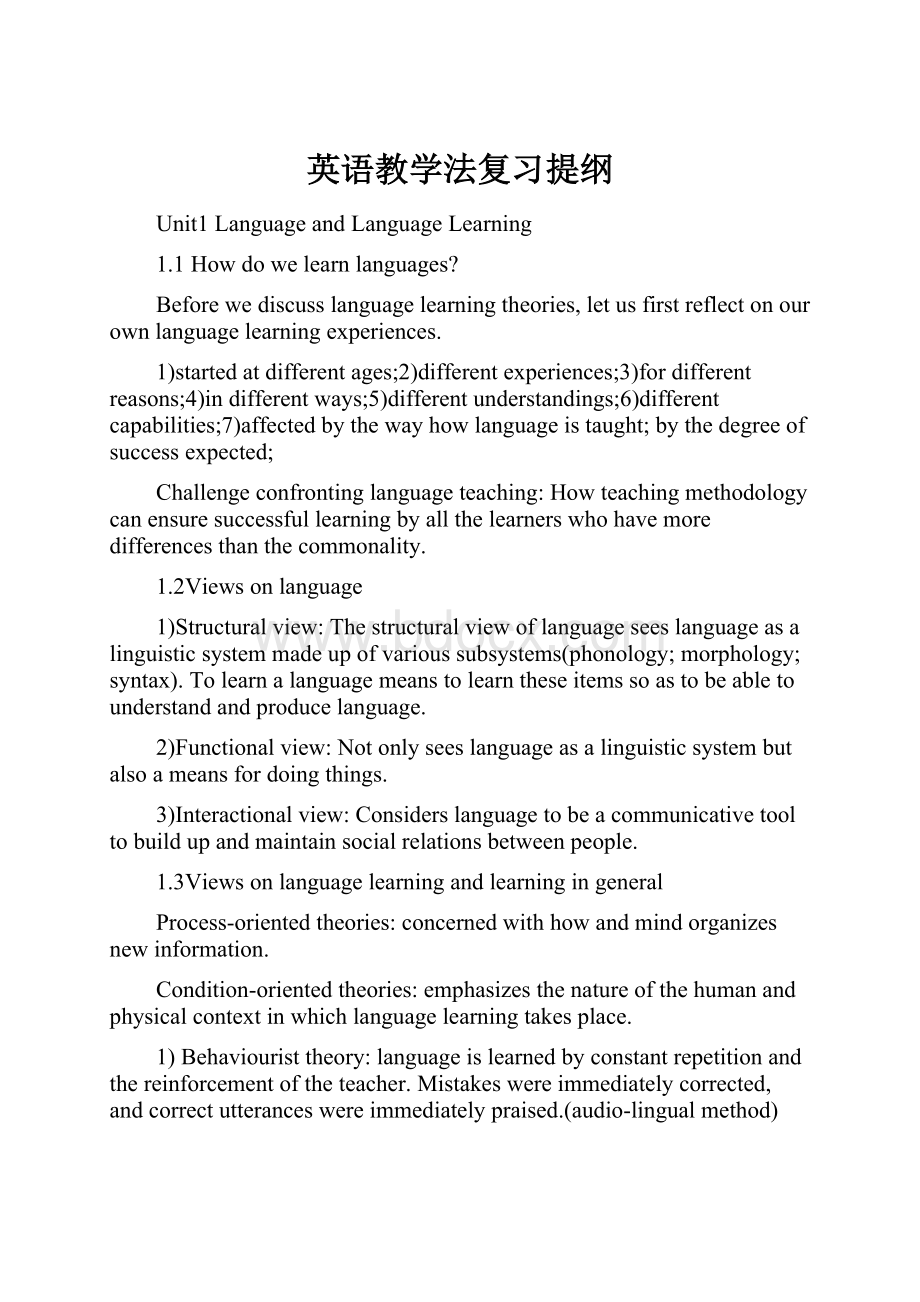英语教学法复习提纲.docx
《英语教学法复习提纲.docx》由会员分享,可在线阅读,更多相关《英语教学法复习提纲.docx(14页珍藏版)》请在冰豆网上搜索。

英语教学法复习提纲
Unit1LanguageandLanguageLearning
1.1Howdowelearnlanguages?
Beforewediscusslanguagelearningtheories,letusfirstreflectonourownlanguagelearningexperiences.
1)startedatdifferentages;2)differentexperiences;3)fordifferentreasons;4)indifferentways;5)differentunderstandings;6)differentcapabilities;7)affectedbythewayhowlanguageistaught;bythedegreeofsuccessexpected;
Challengeconfrontinglanguageteaching:
Howteachingmethodologycanensuresuccessfullearningbyallthelearnerswhohavemoredifferencesthanthecommonality.
1.2Viewsonlanguage
1)Structuralview:
Thestructuralviewoflanguageseeslanguageasalinguisticsystemmadeupofvarioussubsystems(phonology;morphology;syntax).Tolearnalanguagemeanstolearntheseitemssoastobeabletounderstandandproducelanguage.
2)Functionalview:
Notonlyseeslanguageasalinguisticsystembutalsoameansfordoingthings.
3)Interactionalview:
Considerslanguagetobeacommunicativetooltobuildupandmaintainsocialrelationsbetweenpeople.
1.3Viewsonlanguagelearningandlearningingeneral
Process-orientedtheories:
concernedwithhowandmindorganizesnewinformation.
Condition-orientedtheories:
emphasizesthenatureofthehumanandphysicalcontextinwhichlanguagelearningtakesplace.
1)Behaviouristtheory:
languageislearnedbyconstantrepetitionandthereinforcementoftheteacher.Mistakeswereimmediatelycorrected,andcorrectutteranceswereimmediatelypraised.(audio-lingualmethod)
2)Cognitivetheory:
Studentsareaskedtothinkratherthansimplyrepeat.Alanguagelearneracquireslanguagecompetencewhichenableshimtoproducelanguage.
3)Constructivisttheory:
Learningisaprocessinwhichthelearnerconstructsmeaningbasedonhis/herownexperiencesandwhathe/shealreadyknow.
4)Socio-constructivisttheory:
Learningisbestachievedthroughthedynamicinteractionbetweentheteacherandtheleanerandbetweenlearners.
1.4Whatmakesagoodlanguageteacher?
Notsolelydependonhis/hercommandofthelanguage.
1)ethicdevotion;2)professionalqualities3)personalstyles
1.5Howcanonebecomeagoodlanguageteacher?
P9图
1Languagedevelopment;②Learning,practice;③reflection
Unit2CommunicativePrinciplesandTask-basedLanguageTeaching
2.1Languageuseinreallifevs.traditionalpedagogy
CommunicativeLanguageTeaching(CLT):
includesboththeknowledgeaboutthelanguageandtheknowledgeabouthowtousethelanguageappropriatelyincommunicativesituations.
Task-basedLanguageTeaching(TBLT)
Veryoftenthereisabiggapbetweenthelanguageusedinreallifeandthelanguagelearninginclassrooms.
1)R:
Languageisusedtoperformcertaincommunicativefunctions.
C:
Theteachingfocusisoftenonformsratherthanfunctions.
2)R:
Useallskills.
C:
Focusononeortwolanguageskillsandignoretheothers.
3)R:
Usedinacertaincontext.
C:
Tendstoisolatelanguagefromitscontext.
2.2Whatiscommunicativecompetence?
Bridgethegapbetweenclassroomlanguageteachingandreal-lifelanguageuse—CLT
Hedge—Fivemaincomponentsofcommunicativecompetence:
1)Linguisticcompetence:
Concernedwithknowledgeofthelanguageitself,itsformandmeaning.(ItiswrongtothinkthatCLTdoesnotaimforhighstandardoflinguisticcorrectness.
2)Pragmaticcompetence:
Concernedwiththeappropriateuseofthelanguageinsocialcontext.
3)Discoursecompetence:
Referstoone’sabilitytocreatecoherentwrittentextorconversationandtheabilitytounderstandthem.
4)Strategiccompetence:
Strategiesoremployswhenthereiscommunicationbreakdownduetolackofresources.
5)Fluency:
Linkunitsorspeechtogetherwithfacilityandwithoutstrainorinappropriateslownessorunduehesitation.
2.3Implicationsforteachingandlearning(P20)
2.4PrinciplesofCommunicativeLanguageTeaching(CLT)
1)Communicationprinciple;2)Taskprinciple;3)Meaningfulnessprinciple
2.5CLTandtheteachingoflanguageskills
1)Thelisteningskill:
SpecialattentioninCLT;Independentskillwithitsownobjectives.
2)Thereadingskill:
Focusonthepurposeofreading.
3)Thewritingskills:
Focusonitscommunicativegoalsaswell.
4)TheSpeakingskills:
Producewhatismeaningful.Authentic,unpredictable,andcreative.
2.6Mainfeaturesofcommunicativeactivities
Engageavarietyofcommunicativeactivities:
FunctionalcommunicativeactivitiesandSocialinteractionactivities.
Criteriaforevaluatinghowcommunicativeclassroomactivitiesare:
1)Communicativepurpose;2)Communicativedesire;3)Content,notform;4)Varietyoflanguage;5)Noteacherintervention;6)Nomaterialscontrol
2.7Task-basedLanguageTeaching(TBLT)
AfurtherdevelopmentifCLT.However,ithasstressedtheimportancetocombineform-focusedteachingwithcommunication-focusedteaching.
1)Definitionsofatask(P27)
2)Fourcomponentsofatask:
apurpose;acontext;aprocess;aproduct
3)Exercises,exercise-tasksandtasks
Exercises:
Focusonindividuallanguageitems.
Tasks:
Purposeful&contextualizedcommunication.
2.8PPPandTBLT
PPP:
Presentation,practiceandProduction.
DifferencesbetweenPPPandTBLT(P32)
2.9Howtodesigntasks?
Step1Thinkaboutstudents’needs,interests,andabilities.
Step2Brainstormpossibletasks
Step3Evaluatethelist
Step4Choosethelanguageitems
Step5Preparingmaterials
任务设计原则:
1.结构—功能—话题的有机结合为主线
2.言语、情境真实性原则
3.阶梯型任务原则
4.做中学原则
2.10AppropriatenessofCLTandTBLTintheChinesecontext
CLT:
1)Whetheritisculturallyappropriate
2)Itisdifficulttodesignasyllabuswithaonetoonecorrespondencebetweenafunctionandaform.
3)whetheritissuitableforallagesleveloflearnersorallcompetenceleveloflearners.
TBLT:
1)Notbeeffective;notappropriateforthosecontextswherelanguageexposureisnotsufficientandclasstimeislimited.
2)Itneedstimeforteacherstoprepareitverycarefully.
3)Thecultureoflearning.
4)Levelofdifficulty
Despitethesepotentialdrawbacks,TBLTcanhelpstudentslearnEnglishinachallengingandstimulatingway.
Unit3TheNationalEnglishCurriculum
3.1AbriefhistoryofforeignlanguageteachinginChina
1)Foreignlanguageteachingbefore1978;
2)Aphaseofrestoration(1978-1985);
3)Aphaseofrapiddevelopment(1986-1992);
4)Aphaseofreform1993-2000)
5)Aphaseofinnovationfrom2000
3.2DesigningprinciplesfortheNationalEnglishCurriculum
1)Aimforeducatingallstudents,andemphasizequality-orientededucation.
2)Promotelearner-centredness,andrespectindividualdifferences.
3)Developcompetence-basedobjectives,andallowflexibilityandadaptability.
4)Paycloseattentiontothelearningprocess,andadvocateexperientiallearningandparticipation.
5)Attachparticularimportancetoformativeassessment(P43最后一段),andgivespecialattentiontothedevelopmentofcompetence.
6)Optimizelearningresources,andmaximizeopportunitiesforlearningandusingthelanguage.
3.3GoalsandobjectivesofEnglishlanguageteaching
(Comparetotheprevious)
基础教育课程改革三维目标
1.知识与技能
2.过程与方法
3.情感,态度,价值观
OverallLanguageAbility:
Language
LanguageSkills
Cultural:
Knowledge;Understanding;Awareness
Learning:
Cognitive;Selfmanagement;Communication;Resourcing
Affect:
International;Perspectives;Confidence;Motivation
3.4DesignoftheNationalEnglishCurriculum(P46)
(Comparetotheprevious)
3.5Performancestandardsfordifferentlevelsofcompetence(P47)
3.6ChallengesfacingEnglishlanguageteachers
●Change:
1)Theirviewsaboutlanguagewhichisnotasystemoflinguisticknowledgebutameansforcommunication.
2)Theirtraditionalroleofaknowledgetransmittertoamulti-roleeducator.
3)Teachersareexpectedtousemoretask-basedactivitiesandputthestudentsinthecentreoflearning.
4)Usemoreformativeassessmentinadditiontousingtests.
5)Usemoderntechnologyinteaching,creatingmoreeffectiveresourcesforlearningandforusingthelanguage.
●
P49
Difficultiesandproblems
●Tips
Unit4LessonPlanning
4.1Whyislessonplanningimportant?
Alessonplanisaframeworkofalessoninwhichteachersmakeaadvancedecisionsaboutwhattheyhopetoandhowtheywouldliketoachieveit.
Benefits:
1)Awareoftheaimsandlanguagecontentsofthelessons.Plantheactivitiesandchoosethetechniquesaccordingly.
2)Distinguishthevariousstagesofalessonandseetherelationshipbetweenthemsothattheactivitiesofdifferentlevelscanbearrangedproperlyandthelessoncanmovesmoothlyfromonestagetoanother.
3)Anticipatepotentialproblemssothattheycanbepreparedwithsomepossiblesolutionsorotheroptionsforthelesson.
4)Giveconfidence.
5)Planningisagoodpracticeandasignofprofessionalism.
4.2Principlesforgoodlessonplanning
Aimmeanstherealisticgoalsforthelesson.Aimsarenotthethingsteachersintendtododuringthelesson,butthethingsthatstudentsareabletodobytheendofthelesson.
Variety:
Activities;materials
Flexibility:
Someextraandalternativetasksandactivities.
Learnability:
Withinthelearningcapabilityofthestudents.
4.3Macroplanningvs.microplanning
Macroplanning:
planningoveralongerperiodoftime.
Microplanning:
planningforaspecificunitoralesson.
(P54图)
Macroplanninginvolvesthefollowing:
1)Knowingabouttheprofession;2)Knowingabouttheinstitution;3)Knowingaboutthelearners;4)Knowingaboutthecurriculum/syllabus;5)Knowingaboutthetextbook;6)Knowingabouttheobjectives.
4.4Componentsofalessonplan(p55)
(Everylessonisunique,soiseverylessonplan.)
Teachingcontents:
Teachingaims(学生为主体,不要写太多,注意情感教育):
Teachingaids:
Teachingimportantpoints